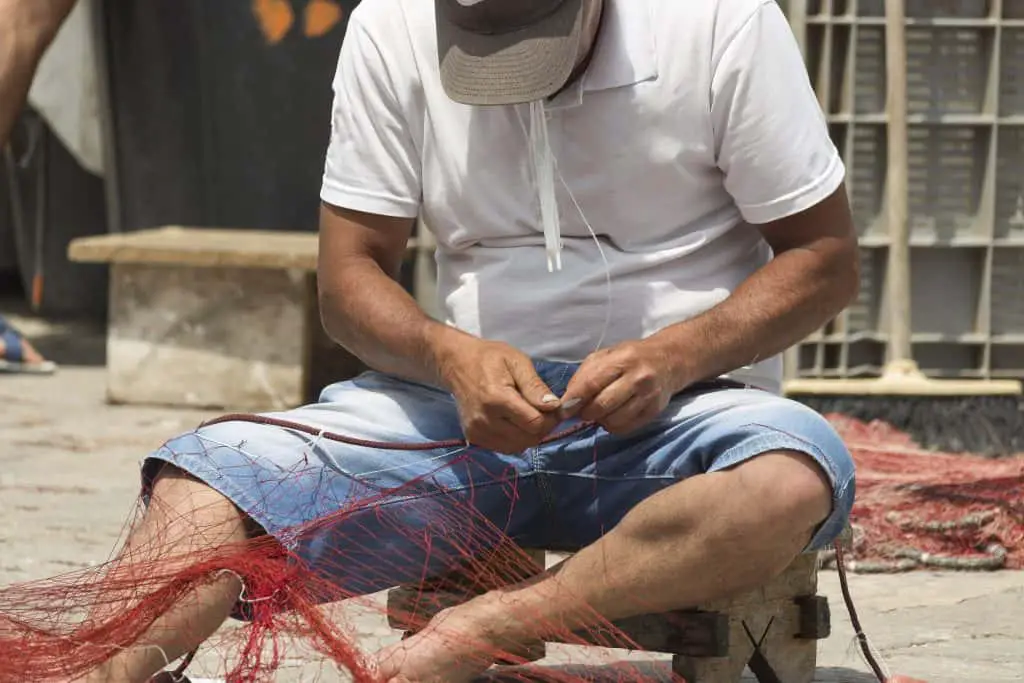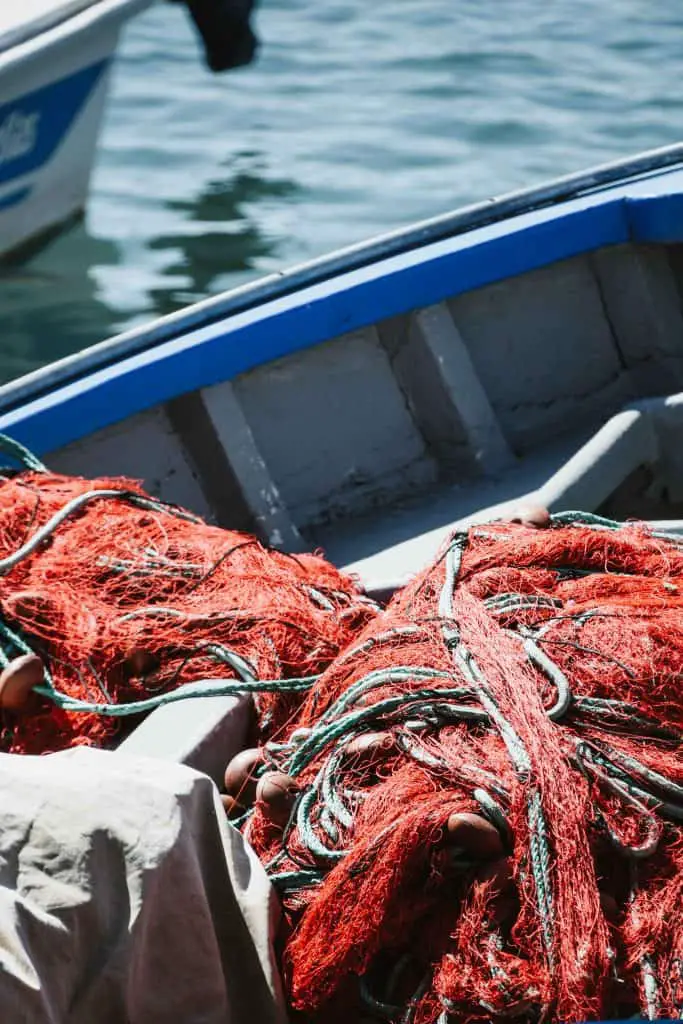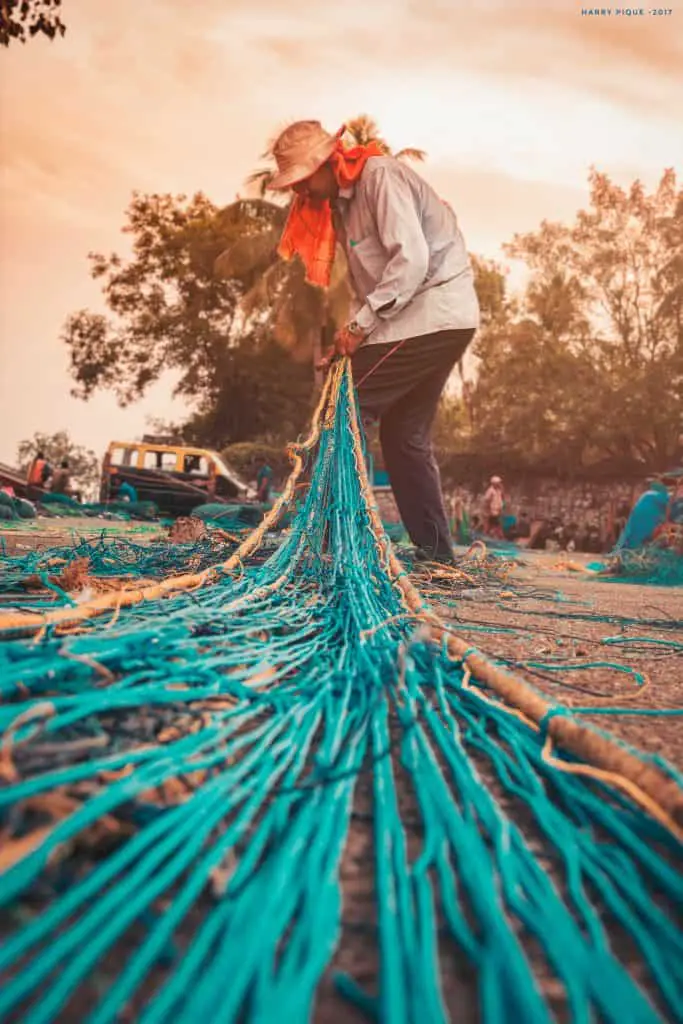I am on the shores of one of New Zealand’s popular waters and the population looks promising. Despite the elbowing because of hundreds of anglers who have come to sport fish, everyone seems to be having so much fun.
‘’What is Drag Net Fishing?’’ I overhear a middle-aged guy holding one of the latest combos from Orvis asking his buddy and I am tempted to join in their conversation. Knowing about the technique, I did and I got a few new angling buddies. I thought it wise to share the info here too.
Drag net fishing is an old fishing technique that involves the use of drag nets that vertically hang on two poles. The fishing action is by dragging the net through the water and create what looks like a bag in the fishing net you want fish to be caught in.
What is Drag Net Fishing?
Drag nets remain vertical in water with the help of floats that are attached to ropes along the edge of the top section of the net. You have to attach weights to a different rope that passes along the edge of the bottom section of the net.
The nets are operated while at the shores. The nets often have long wings. Long ropes attached to the nets are used to two the net back to the beaches. As the head rope floats on the water surface, the footrope remains intact and is permanently in contact with the net’s bottom section.
Hence, the net becomes a barrier that prevents fish from to the other side. They remain in the area that has been enclosed by your net. This applies to both commercial and recreational drag net fishing.
You don’t need special gear or equipment for this type of fishing operation. What is required is two fishermen to tow the drag net back to the beaches. The legalized length of your net shouldn’t exceed 40 meters. You have to use the depth and width of the mesh recommended for your zone.
The first person holding the net will walk out and the other one walks the drag net outwards heading to the other side. Ensure you maintain the deepest level possible. Always confirm that lead lines and floats aren’t twisting over.
The fisherman ties ropes that don’t exceed 8 meters lengthwise onto the float and lead line. He ties the rope onto a lightweight yet stronger pole. They move straight heading to the shore and with the movement, the net curves. Ensure that you walk it in the shallows so that majority of the fish head to the belly of the net. Each drag should cover a new ground.
Check for sharp rocks and large snags in the area you are drag net fishing. To do this, visit your targeted spot when the tides are at their lowest. Use a GPS to mark rocks. In case your net snags up in the course of a drag, have a third person. Their task is to free your drag net. To be more successful am for when there is the final outgoing tide and just when you are about to experience an incoming tide.
It is possible to drag net fish in a middle to high tide. As long as there is more clean ground for hauling your net to the shore, don’t wait. Low tides are among the best but will be even more yielding if the low tide coincides with darkness or very low light. If this happens in the estuaries and harbor, the timing is perfect.

If you are going out to drag net fish in the day, look for discoloured waters. Those who love the surf beaches with plenty of sand should wait for the tides or a specific time. These aspects aren’t as important for such locations. However, go when there are minimal to no waves or swell. You will have longer yet successful drags. Be careful about weeds and several days offshore winds are the best to avoid dragging them.Initially drag nets were weaved from organic materials like hemp. These were easy to decompose. Drag nets that were used before the 1950s had larger-sized mesh to catch large fish only. The smaller ones and fingerlings were allowed to swim out through the mesh.
Currently, these nets are made from synthetic material for durability, no odour to contaminate water, and to be invisible in water. They however aren’t biodegradable.
Most situations will still work with drag nets of 30 meters. These are modest size and manageable especially if you don’t have a third person to help when the net snugs up in rocks. For the 40-meter long drag nets, four people can operate it. Uses dinghies for towing the nets into the deeper waters from the shores. REMEMBER that jurisdictions forbid the fishermen from hauling in the nets mechanically.
Drag net fishing involves wading. Be prepared as you could easily dunk into a deep channel or hole. This often happens near the mouths of rivers or on the surf beaches. Invest in good-quality wading gear and a floatation vest. It might be common sense but some love to dare nature. Have a diver’s knife closer for times when you become a fish and tangle in the drag net. Be cautious when drag net fishing in strong currents. Carry a functional head torch and a backup light if drag netting in the night.
Commercial Drag Net Fishing
Because of how effective it is, drag fishing has become a common commercial fishing technique. Mostly, commercial drag net fishing is done on the sea. The net will hang in the waters of the sea and act as a wall shortly. This net shouldn’t be left here permanently. They work almost similar to tangle and gill nets but how fish get trapped into the net is what differentiates the three.
Inshore fishermen have been forced to responsibly use the drag nets if they need to remain in business. They are required to use nets of larger mesh size to allow fingerlings and smaller fish to escape through ad mature. As the commercial side is basically large scale, this has to happen because of the huge numbers of bycatch. All drag net fishermen are warned to be careful of not abandoning or losing their commercial vessels as they continue to catch fish hence being ghost nets.

Recreational Drag Net Fishing
Drag net fishing is acceptable in some waters but with restrictions. For instance, there are three primary types of drag nets being made by a New Zealand company for drag net recreation fishing on its waters. The piper uses a bait mesh of between 25mm and 75mm. For mullet, you can use the Kahawai mesh-85mm or the Kahawai-flounder, snapper trevally ranging from 100 to 180mm.
Ensure you use the smallest legally accepted mesh size on the drag net. This prevents fish from gilling themselves. You can return all the unwanted species to the water unharmed. Even as you have fun drag net fishing in areas that accept this, follow the set rules and regulations to avoid being on the wrong side of the law. Keep safe always by following all the guidelines of drag net fishing.
Before using a new drag net, adhere to all the precautionary measures to allow for safer use when fishing. While looking to have fun, ensure that you are conserving the environment at the same time modern drag nets are not made from biodegradable material.
Is Drag Net Fishing Legal?
Now that you can define drag net fishing, let us address its jurisdiction before diving deeper into it. Most countries passed a prerogative over waters that are within about 200 nautical miles off the shores. They call them exclusive economic zones. Countries that regulate drag net fishing are also regulated and bound by other international agreements.
Controls have been made clear on drag net fishing as overdoing it can lead to a quick decline in fish stocks. However, many fishermen went contrary and manufacturers had to devise a means of making drag nets that don’t breach the regulations.
Japan has been in the spotlight for exploitative drag net fishing on the North Pacific Ocean. The country had been blamed severally for poaching the Northern Pacific Salmon that affected the Canadian and USA fishing companies and indiscriminatingly destroying marine life.

What is Drag Net Fishing – Conclusion
You can go drag net fishing all through the year. However, of all the seasons, the warmest summer days give the highest yields. At this time, most fish head to the shallow waters. Flounders are usually the primary target for drag net fishing but you can catch various species.
Most of the time, flounders will not tangle in the net. They lazily sit on the mesh of the net. Ensure that you are steadily and smoothly hauling your net ashore. Once you are done, survey your net for holes. If there are any, you must have carried a kit with stitching equipment.
Summers and the start of autumn are the best times to go out with a few buddies to drag net fish. You need preparedness and the right personal gear for safety purposes.